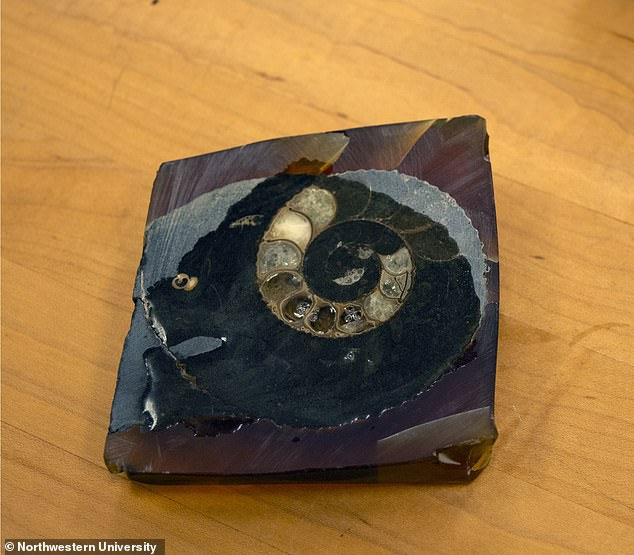Fossil shells help people find the reason that the Earth is increasingly polluted?
According to the Daily Mail, a recent report said that the fact that an asteroid erased the existence of dinosaurs has dealt a blow to the Earth, which is always in a state of tension, instability and standing. on the brink of disaster.
Carbon dioxide (CO 2 ) created by modern India volcanoes creates acidic oceans that partially melt seashells and snails. Tracking how these creatures change over time shows that the planet is struggling with high levels of CO2 in the atmosphere.
"The Earth is clearly under stress" due to a series of horrific extinction events, " said Benjamin Linzmeier from Northwestern University (USA).
The researchers said that, from our understanding of the Earth's response to previous global warming, we can shed light on humanity's battle against the ongoing climate crisis.

A fossil shell found in Antarctica is about to be analyzed in a laboratory.The morphology of the shell changes as the ocean becomes more acidic due to increased carbon dioxide concentration.(Photo: Northwestern University).
Deccan trap - a 200,000 square mile volcanic array that erupted for a long time and released large amounts of greenhouse gases. The oceans absorb CO2 and become more acidic, in turn affecting the animals that live there.
This also led to a change of ancient fossil shells in Antarctica that led to the post-collision phase with Chicxulub asteroid, creating chaos with the Earth.
Researchers at Northwestern University measured the calcium isotope composition of fossil clam and shellfish. At the same time, they linked the changing morphology of the fossils to the persistent eruptions of the Deccan trap.
"Our data shows that the environment has changed before the asteroid's impact. Those changes seem to correlate with the eruption of the Deccan Trap," said Dr. Linzmeier, the first author of the study. know.

A fossil, collected from Antarctica in a laboratory at Northwestern University, USA.(Image: Northwestern University)
The researcher also said that the impact of sperm asteroid on previous carbon cycle instability. But this does not mean that we have the answer to what actually caused the extinction.
Snail shells can provide important clues that show the level of carbon dioxide in the history of atmospheric fluctuations. CO 2 increases the acidity of the oceans, changing the way shells form, as more acidic water can dissolve calcium carbonate shells.
By a new method developed at Northwestern University, single isotope calcium can be detected. These calcium shells will be dissolved, transformed into the base substance and fed into various analyzers, including mass spectrometry.
"We can measure calcium isotope variations with great accuracy," said Dr. Andrew Jacobson, lead author of the study.
The team expected to see some changes in the shell's composition, he added, but the rapid change in practice surprised them.
Besides, they were also surprised not to see many changes related to the extinction of dinosaurs.

Researchers at Northwestern University in the United States measured the calcium isotope composition of fossil clam shells and shells before dinosaur extinction.(Photo: Northwestern University).
The researchers say that being able to understand how the planet has responded to high levels of carbon dioxide in the past can help us understand the current state of greenhouse gas emissions.
"To some extent, we think ancient ocean acidification events are good for what is happening to man-made CO 2 emissions , " said Dr. Jacobson.
The study will be published in the January 2020 issue of the journal Geology Geology.
- Sea snail fossils have been found more than 240 million years ago in Nghe An
- The 5-year-old girl dug in a shell of 160 million years
- Fossil egg shells of ostriches confirm the theory of continental drift
- Where the boys disappeared
- Find jewels in a 100 million year old son
- Discovered fish live in contaminated water 1,000 times
- 80,000 year old seashells - the oldest jewelry on earth
- Discovered the first artwork of prehistoric people
- Asian cities are increasingly polluted
- Harm of polluted water
- The truth about shrimps is that many people think they know that they turned out to be wrong
- What is rare earth means to people
- Fruit peels can also save lives
- Learn the world's oldest brain fossil
 Discovered an ancient centipede fossil 99 million years old
Discovered an ancient centipede fossil 99 million years old Discovered bat-like dinosaurs in China
Discovered bat-like dinosaurs in China Discovered a 200-year-old bronze cannon of the coast
Discovered a 200-year-old bronze cannon of the coast Discover 305 million-year-old spider fossils
Discover 305 million-year-old spider fossils